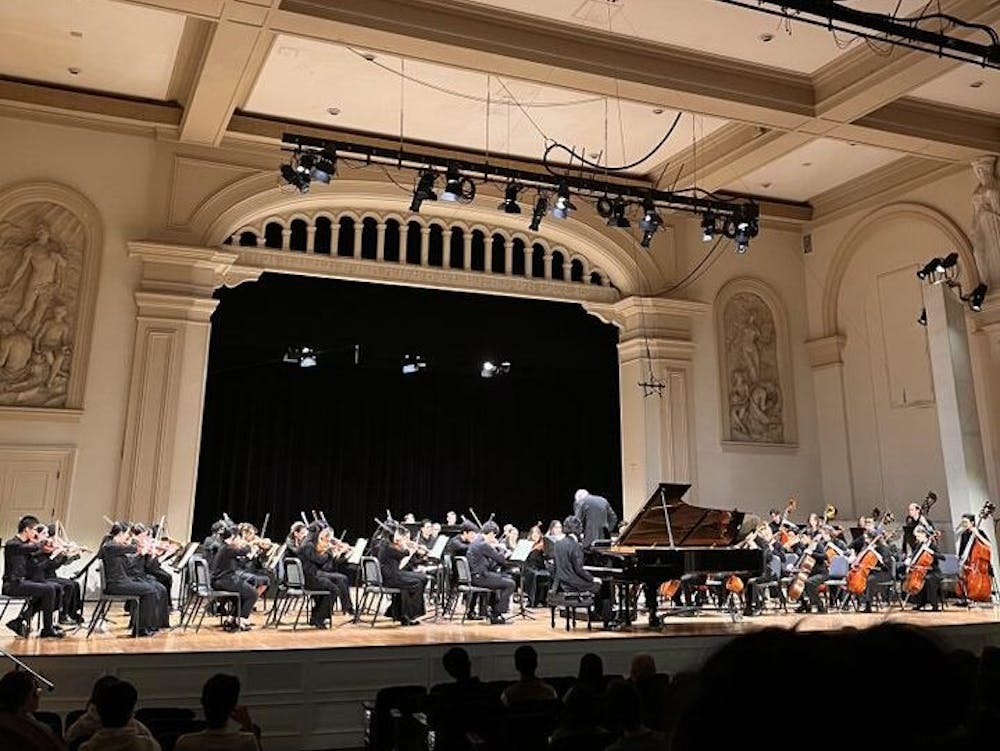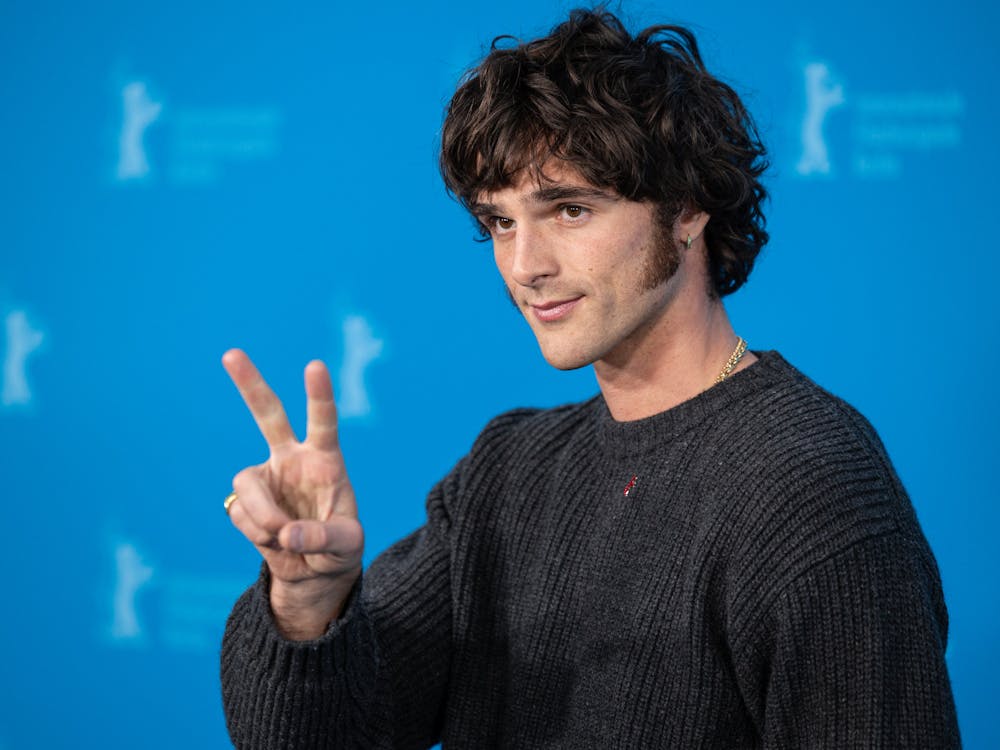The Peabody Concert Orchestra (PCO) displayed an exceptional performance on Saturday, Nov. 9 in the Miriam A. Friedberg Concert Hall. The excitement in the packed hall could be felt, especially as Dean of the Peabody Institute Fred Bronstein dedicated the opening of the annual PCO in memory of Steven Muller — former president of the Johns Hopkins University and the Johns Hopkins Hospital — who passed away in 2013. The program notes describes him as — “a visionary leader who reshaped and reinvigorated JHU during his long tenure as president.”
The concert began with a composition by the winner of the 2024 Macht Orchestral Composition Competition, Young Jun Lee. The piece — titled Geworfenheit — began with a sharp, pinching entry by the symphony. It filled the atmosphere with trickling vibrating noises, and the plucked strings created a foreign sound, as though one was inside a boom box. The cacophony steadily enveloped the hall, created through a mix of brass, percussion and the concertmaster’s solo — almost like hearing different types of animals at a zoo.
The piece oscillated between producing an entrancing sound to then creating distance with the audience, pulling them in and out of the music. Running notes were then exchanged with with blaring sounds from the brass section. These commotions gave an image of a haunted carnival house in the middle of the woods, as if clowns would jump out at you any second from behind the trees. The notes felt like a textured mix of a clock chime combined with a bunch of screaming. To enhance the movie-like effects, the percussive bass drum in the back helped to create more active layering in order to keep the audience on its toes.
The first movement, Prélude a la nuit of Maurice Ravel’s Rapsodie espagnole began with violins supported by the cello and bass with pizzicatos. The melody the violins introduced laid out the motifs throughout this piece — the first layer of music. The woodwinds then took over the motif, while the violins moved onto a different moving melody. In between, the first violinist had a beautiful flowing melody, which smoothly transitioned back into the original motif, joining the rest of the violins.
The next movement — Malagueña — involved more active sounds with prominent pizzicatos by the cellos and basses. The movement was reminiscent of a warrior movie where a hero goes on a solo journey. It was almost like a scene from “Kung Fu Panda” where Po heads off to an adventure with a bamboo stick in hand, conical hat and a poised stance, which flow into a cheerful melody. The motif from the first movement also came back throughout this movement with very clean runs by the flutes.
In an interview with The News-Letter, harpist Amrita Sankrit described the process of learning her part while actively trying to apply new techniques she had acquired throughout the semester.
“I’ve never really played this piece before, so it was a nice little journey,” Sankrit said. “Since coming to Peabody, my professor has remodeled my technique to make it better fit with the French-trained technique, changing things like hand position and the amount of strength I put into the strings changed. Especially in the second and fourth movement, there are chordal sections where I really dug into the chords and played with more power.”
The third movement Habañera began in reverse structure to the first movement: The woodwinds opened with the melody with the addition of the elegant harp electrifying the music. The concertmaster and the associate of the first violin section had a sweet melody played with a lot of chemistry. The melody throughout the movement was especially charming as it carried the section to the very end.
Sankrit also mentioned the importance of understanding how all of the different orchestra parts interact with one another to produce the suitable tones for the piece.
“You have to really listen to the music,” Sankrit said. “Make sure to count, look at the conductor and understand what is happening before, after and when you come in. In this piece, I have glissandos that I have to hold and count for different intervals of time. [In order to play it correctly], I had to watch for the downbeat and listen for the correct motives and patterns.”
Feria — the final movement — began with a flute melody followed by an array of dulcet strings from the harp with an underlying support by the rest of the orchestra. The percussionist playing xylophone had remarkable precision alongside the vibrant energy flowing throughout like a celebration. An eerie sound by the first cello stand followed this section with the rest of the strings playing a motif that sounded like the question: What are you doing here?
The motif played by the strings repeated like an exchange, enhanced by layers of woodwinds and brass. Additionally, the percussive bells and the clash of the cymbals added a cheerful atmosphere to the piece, as the melody seeped in to revive the audience once again. The ending was glorious with a heroic spirit culminating in a dramatic finish.
After the intermission, the anticipation for the Johannes Brahms Concerto No. 1 in D minor for Piano, Op. 15 by pianist Yang Gao — winner of the 2023 Harrison-Winter Piano Competition — could be felt as everyone settled down once again in the auditorium. As Gao entered the stage, his presence resonated deeply into the audience as he took his place at the piano. Immediately, the triumphant opening of the first movement Maestoso began with the orchestra filling the auditorium with trills that set the tone for the piece. The violin’s melodic line followed, complemented by the cellos.
After sitting for around two minutes, Gao came in with exuberance, graced with a sensitive touch and eloquent articulations. He built up the section with great trilled scales that ascended and descended beautifully, leading into a melodic line played solely by the pianist. Following the melody, the woodwinds took over with the melodic line followed by the entire orchestra joining the tune, leaving Gao to create the harmonies. Soon after, the melody was exchanged back to the pianist supported by the cello and bass sections, and the orchestra came back together again. Gao showed off his impressively clean octave work; the exchange between the pianist and orchestra was energetic which made the entire performance that much more meaningful.
The pianist expressed very tender melodies which drew in on the intimacy of the piece, creating a nice contrast between the build up created by technical octave passages, drawing in on a lively section leading to the climax. The octave trills by the pianist were played with ease, showcasing his musical abilities, as he entered into the solo cadenza moment. As he added his finishing touches for the first movement, the woodwinds came in with a sweet melody followed by the strings.
Before the transition into the second movement Adagio, a humorous moment arose when the pianist pointed out that the stick holding up the piano lid was not in the right position.
The Adagio was led by the strings, and the cellos were able to create a foundational line that guided the music very well. The pianist came in with a simple melody that captivated the audience with a mellow warm tone. The strings were also able to create an impressive sound that was very clean with a pleasing harmonic line. The section was so quiet and yet it felt like an escape from the chaotic world, which was emphasized by a sudden change in the rising dynamics with a mesmerizingly gorgeous melody.
The final movement Rondo: Allegro non troppo began with fast runs by Gao, which diverged from the slow second movement. The downward scale by the pianist was flawless. The striking melody gave an intense feeling which quickly transitioned into a different section that felt more lighthearted. The transition, however, did not last as the theme came back again, with a triumphant dialogue between Gao and the orchestra.
As the musicians moved toward the climax, there was a sudden change in the harmonization with Gao’s clean leaps heading into another cadenza. The maestoso gesture really came out with all of the amazing runs, chords and arpeggiations, which finally came to an end with the jubilant orchestra. As Gao took his finishing bows, the crowd rose from their seats, loud claps overflowing the auditorium.
“Considering we only had two weeks of rehearsal, it was really amazing to see just how much good music we could make in the very short amount of time,” Sankrit said. “It was a great concert, and I’m so glad that I was [able to play in it].”





